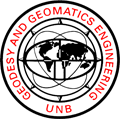| UNB News Release: B527 | Release date: December 6, 1999 | Contact: Sandra Howland |
Satellite Aircraft Navigation Closer to Reality Thanks to UNB
A whole new way of flying is one step closer to reality thanks to researchers at the University of New Brunswick in Fredericton.
"Aviation authorities around the world are collaborating on the development and adoption of satellite navigation," says Richard Langley of UNB's department of geodesy and geomatics engineering.
"Using the Global Positioning System (GPS) of 24 or more satellites orbiting the Earth, it's feasible for aircraft to travel in a straight line from airport to airport instead of following paths defined by ground-based transmitters."
By reducing the distances flown, satellite navigation will result in significant cost savings for airlines.
Satellite navigation promises even greater benefits by supporting better approaches to more runways. This means that aircraft will be able to land safely in lower visibility conditions, reducing delays and resulting in better service for air travelers.
To make the transition to satellite navigation possible, the accuracy, integrity and availability of GPS must first be enhanced to meet aviation's stringent standards.
"If uncorrected, the effect of the atmosphere, for example, can degrade the accuracy of GPS," says Dr. Langley. "The software in an aircraft's GPS receiver needs to compensate for the effect of both the ionosphere and the troposphere on the GPS signals."
To enhance GPS, service providers like Nav Canada and the U.S. Federal Aviation Administration (FAA) are putting in place Wide and Local Area Augmentation Systems (WAAS and LAAS). While LAAS will use facilities at airports to transmit correction data to approaching aircraft, WAAS will use satellites to relay the necessary data over a wide area.
"WAAS data will include corrections for ionospheric delay," says Dr. Langley. "But the correction for the troposphere, being a local effect, must be computed by the aircraft's WAAS-capable GPS receiver."
That's where UNB comes in.
"The FAA and Nav Canada agreed that putting together the tropospheric model for the aircraft WAAS receiver would be a Canadian responsibility," explains Dr. Langley. "Based on our experience and expertise, Nav Can contracted us to do it.
"We selected, enhanced, and tested the model components, including a database of reliable meteorological values. With our model as an important component, WAAS reliably enhances GPS accuracy from about 100 metres to less than 10."
UNB's tropospheric delay model has been accepted by Nav Canada and the FAA and is well on its way to being adopted around the world.
"It is already being tested by the Europeans," says Dr. Langley, who adds that his department's contract with Nav Canada is ongoing.
"Now we're focusing on the ionosphere."
UNB's work with Nav Canada has given graduate students like Paul Collins the opportunity to contribute to a world-class research project. He coauthored the contract reports on the UNB model with Dr. Langley and following graduation accepted a job with the geodetic survey division of Geomatics Canada.
As to the future of satellite navigation: "The airlines want the service providers to have the augmentation systems in place before they install new receivers," says Dr. Langley. "And we're looking at global adoption of WAAS and LAAS within about five years."
In the not-so-distant future, the WAAS tropospheric delay algorithm developed at UNB will be the standard in aircraft around the world.


